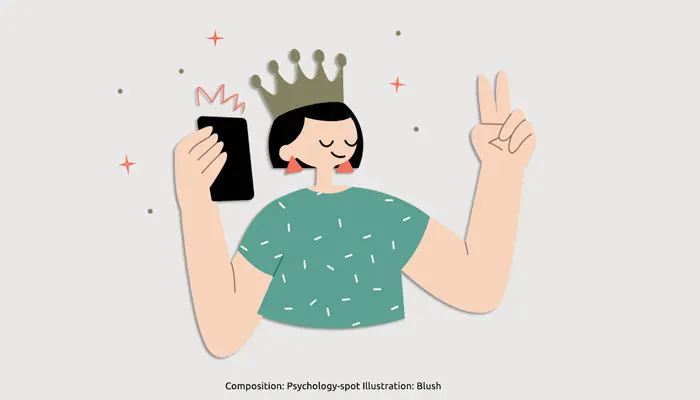
If Narcissus, the mythological character who fell into the water because he was contemplating his reflection, lived today he would flood his social networks with selfies in which he would appear in the foreground showing his enviable physique and his perfect life.
We live in a time when narcissism has penetrated deeply: we seek the approval of friends – although it would be more appropriate to say followers, which is not the same – in social networks to feel good about ourselves. And every time we receive a “like”, our ego grows. To get those “likes” many people project an idealized version of themselves, feeding the character they want to be and not what they really are.
What is digital narcissism?
With the arrival of information technologies, and in particular of social networks, digital narcissism has proliferated. It’s a set of communication practices typical of the 2.0 universe based on an egocentricity so accentuated that it borders the pathological.
Digital narcissism is expressed through a series of “extreme” actions, such as taking a large number of selfies or sharing moments, which we could classify as too intimate, of our lives, practically every day.
Sharing – or rather, sharing excessively – is the way these digital narcissists have to be in the world, it becomes an instantaneous gesture, without thinking, a natural extension of itself. Showing – sometimes spectacularly, and the more spectacularly, the better – has become their main way of existing: they only exist if they can be seen and recognized.
The psychiatrist Serge Tisseron referred to this phenomenon as “extimacy”, a concept he borrowed from Jacques Lacan and which indicates the “Desire to show fragments of one’s privacy of which we ignore the value, at the risk of causing disinterest or even rejection in the interlocutors, but with the hope that their gaze will recognize their value and make it a reality before our eyes”.
Therefore, online extimacy has a specific purpose: seeking approval and admiration, which is expressed through the amount of “likes” that you get for each photo and the compliments that confirm the image and the idea you want to convey of yourself.
This creates a loop that self-feeds itself, especially when they receive positive responses, confirming the theory of uses and gratifications, which says that the more a person perceives that a medium satisfies some of his needs, the more he will use it precisely for that purpose, especially if that person believes that he is not able to satisfy those needs in the real world in the same way.
Radiography of the digital narcissist
“Fiercely competitive in his claim of approval and applause, he mistrusts competition because he unconsciously associates it with an excessive desire for destruction […] Greedy as long as his cravings know no limits, demands immediate satisfaction and lives in a state of restless and permanent desire dissatisfied”, is how sociologist Christopher Lasch described the modern narcissist.
The digital narcissist finds in social networks the ideal means to satisfy his needs, and these in turn feed back those needs, as confirmed by a study carried out in the universities of Swansea and Milan. These researchers discovered that two thirds of people tend to use social networks primarily to publish selfies, which shows that social networks serve as multipliers of the desire to be the center of attention and satisfy that deep need for admiration.
In that same study it was also appreciated, for the first time, that participants who used to publish an excessive number of selfies, showed 25% more of narcissistic traits, going beyond the clinical limit of what is considered a narcissistic personality disorder.
However, social networks do not attract all types of narcissism equally. Another study conducted at the University of Florence concluded that social networks mainly attract vulnerable narcissists, those who feel more insecure and have lower self-esteem, since in the online environment they feel more confident than in real interactions, that’s why they use social networks as a means to get the admiration they want.
The disappearance of the Other and the existential anguish
The phenomenon of digital narcissism is complex. The philosopher and sociologist Jean Baudrillard Reims believed that part of the explanation lies in the disappearance of the Other, which is due – among other factors – to the absolute availability of others despite distances.
In practice, with the technologies that transcend distances, is created a constant presence, there is a feeling that the Other is “immediately present” but at the same time, “implicitly non-existent”. It’s a paradox, because the fact that the others can be present – without being physically – almost immediately, makes the mental exercise of imagining the other useless.
We don’t need to imagine what we can have virtually before us. But the virtual is not completely real. That dichotomy would imply the fall of the Other giving way to a reinforcement of the specular, of narcissism. The absence of the Other translates into people obsessively worried about themselves, who, faced with the fear of loneliness and helplessness, are tormented by the existential anguish that comes from being more connected but alone.
Digital narcissism would be, after all, the expression of an extreme egocentricity fueled by the existential anguish that generates an individualistic and competitive society in which people are valued less for what they are and more for what they appear. A society in which it’s not built inwards but outwards, leaving the interior so empty that it has to be propped up by “like” on artificial images.
Worst of all, many of the digital narcissists are not fully aware of it. Immersed in the “hypermodern” paradox, they consider themselves to be “Mature, responsible, organized, effective and adaptable people; open, critical and skeptical adults; but at the same time they are unstructured, unstable, influenceable, frivolous and superficial”, as philosopher and sociologist Gilles Lipovetsky points out.
What is the antidote to digital narcissism?
It is important to be aware that it’s difficult – if not impossible – to save those who don’t want to be saved. Therefore, it doesn’t make sense to begin a crusade against digital narcissism because it should be a process of individual deconstruction.
Digital narcissists should keep in mind, however, that the image they are projecting is not realistic and, therefore, the approval they receive is to a reflection, not to themselves. That leads to disappointment, at best, and false delusions of greatness that disconnect them completely from the world, in the worst case.
Living to pose is not living, it means losing the most authentic experiences of life. Letting self-esteem and mood fluctuate according to the amount of “likes” that has received the last published selfie involves putting yourself completely in the hands of a mass that can sometimes become particularly cruel. The narcissistic personality, contrary to what many people think, is not built to be bulletproof, but is a fragile glass armor.
The best way to get rid of digital narcissism is to learn to disconnect, to connect with the real world. It’s not about abandoning social networks, but about using them in their proper measure, and not focusing only on one but developing a broader approach.
Authenticity is also a good antidote to conjure the digital narcissism of modern times. Finally, as Carl Jung said: “The privilege of your life is to become who you really are”, everything else is banal.
Sources:
Lazzeri, M. (2019) Il Narcisismo digitale e le patologie da iperconnessione. In: State of Mind.
Reed, P. et. Al. (2018) Visual Social Media Use Moderates the Relationship between Initial Problematic Internet Use and Later Narcissism.The Open Psychology Journal; 11(1): 163-170.
Casale, S. et. Al. (2016) Grandiose and Vulnerable Narcissists: Who Is at Higher Risk for Social Networking Addiction? Cyberpsychol Behav Soc Netw; 19(8): 510-515.



